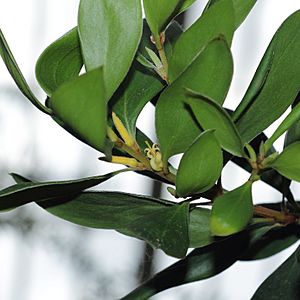Persoonia stradbrokensis facts for kids
Quick facts for kids Persoonia stradbrokensis |
|
|---|---|
 |
|
| In Kew Gardens | |
| Scientific classification | |
| Genus: |
Persoonia
|
| Species: |
stradbrokensis
|
Persoonia stradbrokensis is a special kind of flowering plant that grows only in eastern Australia. It's often called a geebung. This plant can be a tall bush or a small tree. It has young branches that feel a bit fuzzy, and its leaves are shaped like an oval or an egg. When it blooms, it shows off pretty yellow flowers that grow in groups.
What it Looks Like
Persoonia stradbrokensis is a bush or tree that usually grows between 1 and 6 meters (about 3 to 20 feet) tall. The bark on its upper part is smooth, but closer to the ground, it's rough. When the young branches first grow, they are covered in soft, grayish-brown hairs.
Its leaves are wide and shaped like an oval or an egg. They are about 3 to 11 centimeters (1 to 4 inches) long and 1 to 4 centimeters (0.4 to 1.6 inches) wide. When the leaves are new, they also have hairs on them.
Flowers and Fruit
The flowers of this geebung grow in groups of up to twenty. They are arranged along a stem called a rachis, which can be up to 10 centimeters (4 inches) long. This stem keeps growing even after the flowers have bloomed. Each flower sits on a tiny stalk, called a pedicel, which is about 1 to 4 millimeters long. At the base of each flower, there's a small leaf or a scale-like leaf.
The flower parts, called tepals, are yellow and about 10 to 13 millimeters (0.4 to 0.5 inches) long. This plant mostly flowers from December to May. After flowering, it produces a fruit called a drupe. A drupe is a fleshy fruit with a hard pit inside, like a peach or a plum.
Plant History
How it Got its Name
The plant Persoonia stradbrokensis was first officially described in 1921. A scientist named Karel Domin gave it its formal name. He wrote about it in a book called Bibliotheca Botanica. He had collected samples of this plant on Stradbroke Island in 1910. That's why the plant's name includes "stradbrokensis," which means "from Stradbroke Island."
Where it Grows
This geebung plant is found in coastal areas of eastern Australia. It grows in different places, from sandy coastal heathlands to forests. You can find it between Tin Can Bay in south-eastern Queensland and the Hastings River in north-eastern New South Wales.

